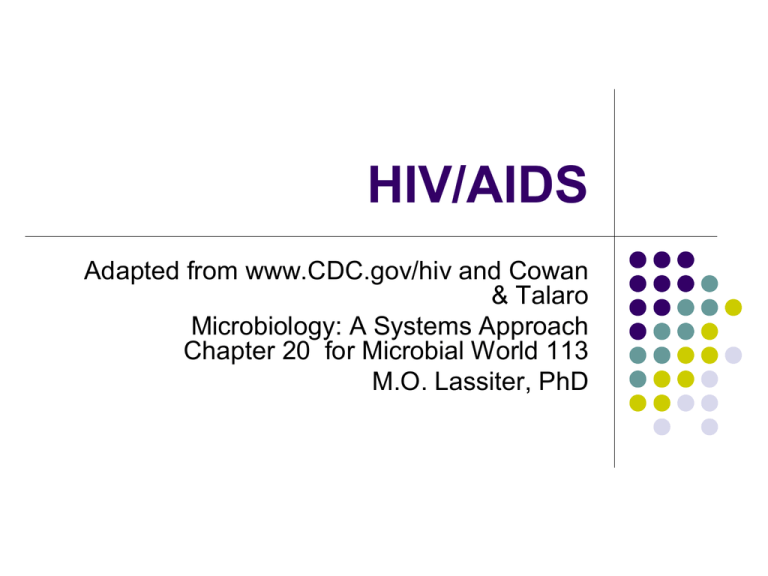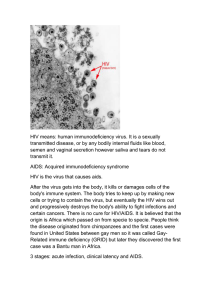HIV/AIDS
advertisement

HIV/AIDS Adapted from www.CDC.gov/hiv and Cowan & Talaro Microbiology: A Systems Approach Chapter 20 for Microbial World 113 M.O. Lassiter, PhD What is HIV? l l l l HIV (human immunodeficiency virus) is the virus that causes AIDS. Can be passed from person to person when infected blood, semen, or vaginal secretions come in contact with an uninfected person’s broken skin or mucous membranes. Infected pregnant women can pass HIV to their baby during pregnancy or delivery, as well as through breast­feeding. Some HIV infected persons will develop AIDS What is AIDS? l AIDS stands for acquired immunodeficiency syndrome. l Some people infected with HIV will progress to have AIDS l A diagnosis of AIDS is made by a physician using specific clinical or laboratory standards. What is AIDS? www.CDC.gov/hiv l Acquired – the disease is not hereditary but develops after from contact with a disease causing agent (in this case, HIV). l Immunodeficiency – the disease is characterized by a weakening of the immune system. l Syndrome – refers to a group of symptoms that collectively indicate or characterize a disease. Retroviruses l enveloped, ssRNA viruses l encode reverse transcriptase enzyme which makes a DNA copy of their RNA genome Video l Human Immunodeficiency Virus (HIV) the cause of Acquired Immunodeficiency Syndrome (AIDS) l HIV­1 & HIV­2 l T­cell lymphotropic viruses I & II ­ leukemia Video Video AIDS l l l l l l l first emerged in early 1980s HIV­1 & HIV­2 are not closely related HIV­1 may have originated from a chimpanzee virus 1959 first documented case of AIDS HIV is found in blood, semen, & vaginal secretions. HIV is transmitted by sex, sharing needles, and mother to child. HIV does not survive long outside of the body. HIV l attacks the T helper cells & macrophages l first signs of AIDS are opportunistic infections such as Pneumocystis carinii pneumonia (PCP) and cancers such as Kaposi sarcoma Video Video HIV l treatments l l l l l inhibit viral enzymes: reverse transcriptase, protease, integrase inhibit fusion inhibit viral translation no vaccine prevention l l l monogamous sexual relationships condoms universal precautions HIV/AIDS Conclusions: Proper protection Treatment with antiviral drugs No current vaccine Vaccine would not help those already infected Problems with resistance to drugs? Worldwide patterns Meets definition of a pandemic






